1997 ACURA NSX light
[x] Cancel search: lightPage 949 of 1503
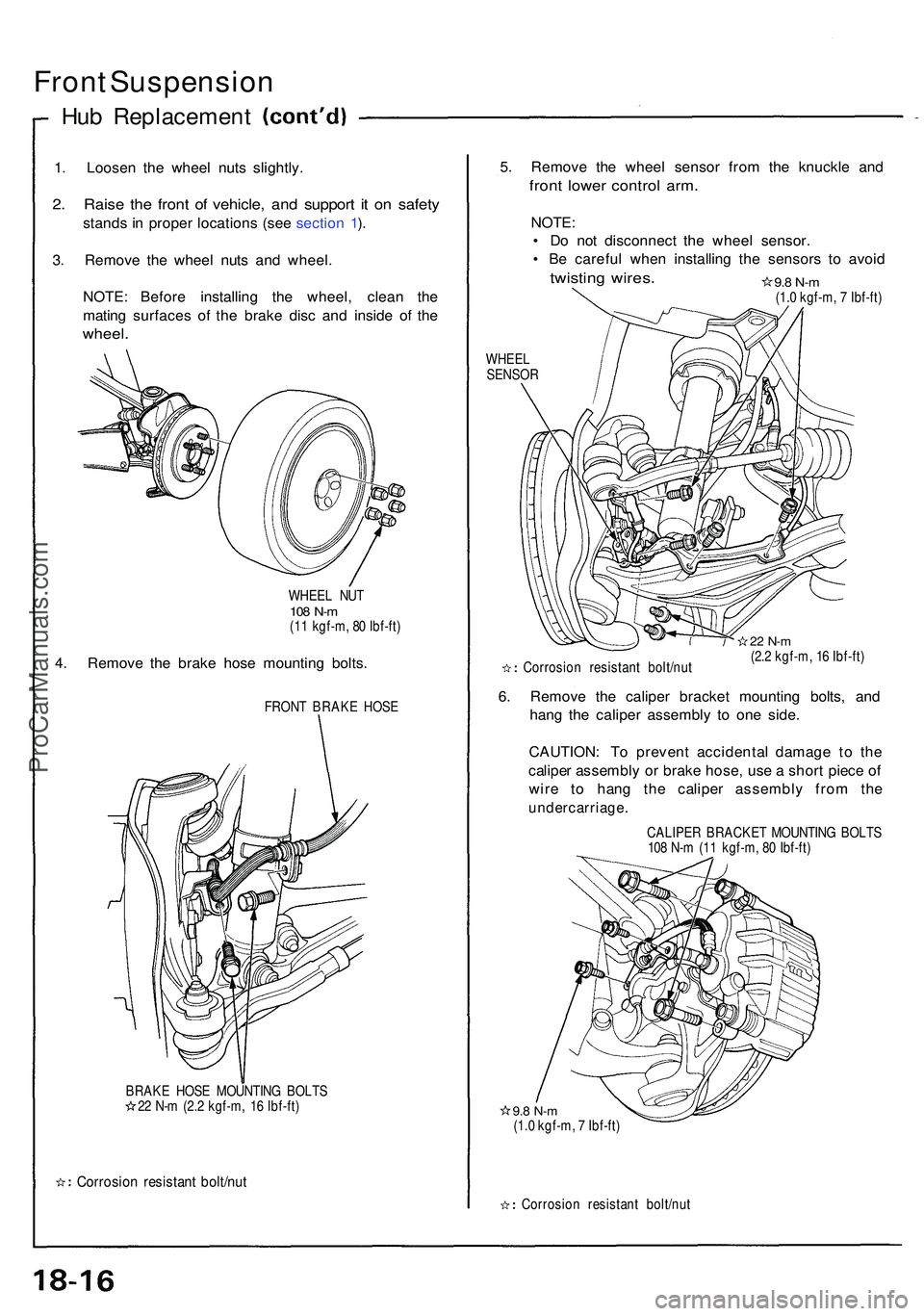
Front Suspensio n
Hub Replacemen t
1. Loose n th e whee l nut s slightly .
2. Rais e th e fron t o f vehicle , an d suppor t i t o n safet y
stands i n prope r location s (se e sectio n 1 ).
3 . Remov e th e whee l nut s an d wheel .
NOTE : Befor e installin g th e wheel , clea n th e
matin g surface s o f th e brak e dis c an d insid e of the
wheel .
WHEE L NU T108 N- m(11 kgf-m , 8 0 Ibf-ft )
4. Remov e th e brak e hos e mountin g bolts .
FRON T BRAK E HOS E
BRAK E HOS E MOUNTIN G BOLT S
2 2 N- m (2. 2 kgf-m , 1 6 Ibf-ft )
Corrosio n resistan t bolt/nu t
5. Remov e th e whee l senso r fro m th e knuckl e an d
fron t lowe r contro l arm .
NOTE :
• D o no t disconnec t th e whee l sensor .
• B e carefu l whe n installin g th e sensor s t o avoi d
twistin g wires .
WHEE L
SENSO R
Corrosio n resistan t bolt/nu t
22 N- m(2.2 kgf-m , 1 6 Ibf-ft )
6. Remov e th e calipe r bracke t mountin g bolts , an d
han g th e calipe r assembl y t o on e side .
CAUTION : T o preven t accidenta l damag e t o th e
calipe r assembl y o r brak e hose , us e a shor t piec e o f
wir e t o han g th e calipe r assembl y fro m th e
undercarriage .
CALIPER BRACKE T MOUNTIN G BOLT S
10 8 N- m (1 1 kgf-m , 8 0 Ibf-ft )
9.8 N- m(1.0 kgf-m , 7 Ibf-ft )
Corrosio n resistan t bolt/nu t
9.8 N- m(1.0 kgf-m , 7 Ibf-ft )
ProCarManuals.com
Page 959 of 1503
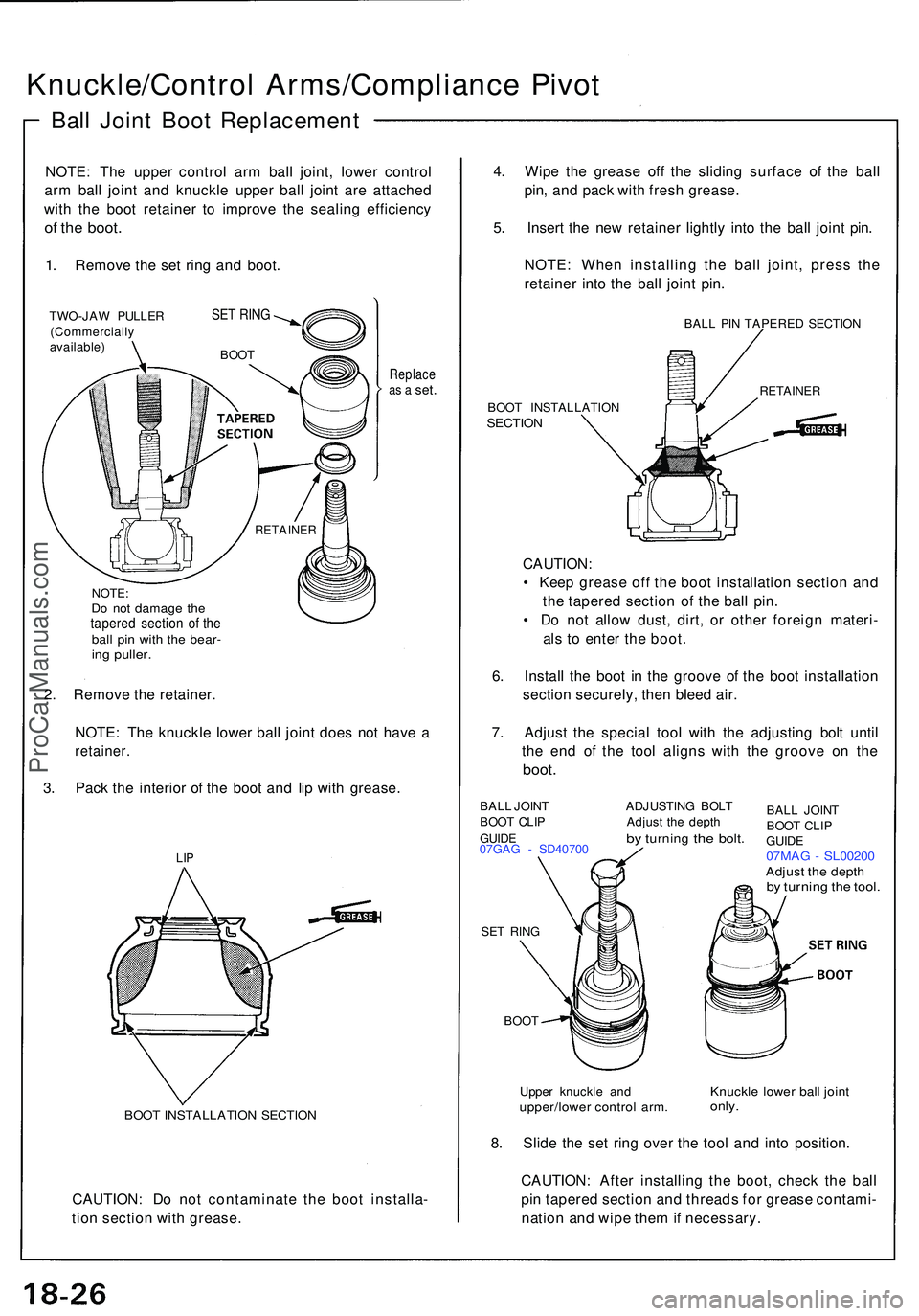
Knuckle/Control Arms/Complianc e Pivo t
Ball Join t Boo t Replacemen t
NOTE: Th e uppe r contro l ar m bal l joint , lowe r contro l
ar m bal l join t an d knuckl e uppe r bal l join t ar e attache d
wit h th e boo t retaine r t o improv e th e sealin g efficienc y
of th e boot .
1. Remov e th e se t rin g an d boot .
TWO-JA W PULLE R
(Commerciall y
available )
Replaceas a set .
NOTE :Do no t damag e th etapere d sectio n o f th ebal l pi n wit h th e bear -ing puller .
2. Remov e th e retainer .
NOTE : Th e knuckl e lowe r bal l join t doe s no t hav e a
retainer .
3. Pac k th e interio r o f th e boo t an d li p wit h grease .
BOOT INSTALLATIO N SECTIO N
CAUTION : D o no t contaminat e th e boo t installa -
tio n sectio n wit h grease . 4
. Wip e th e greas e of f th e slidin g surfac e o f th e bal l
pin , an d pac k wit h fres h grease .
5 . Inser t th e ne w retaine r lightl y int o th e bal l join t pin .
NOTE : Whe n installin g th e bal l joint , pres s th e
retaine r int o th e bal l join t pin .
BAL L PI N TAPERE D SECTIO N
BOO T INSTALLATIO N
SECTION
CAUTION :
• Kee p greas e of f th e boo t installatio n sectio n an d
th e tapere d sectio n o f th e bal l pin .
• D o no t allo w dust , dirt , o r othe r foreig n materi -
al s t o ente r th e boot .
6 . Instal l th e boo t i n th e groov e o f th e boo t installatio n
sectio n securely , the n blee d air .
7 . Adjus t th e specia l too l wit h th e adjustin g bol t unti l
th e en d o f th e too l align s wit h th e groov e o n th e
boot .
BAL L JOIN T ADJUSTIN G BOL T
BOO T CLI P Adjus t th e dept h
GUIDE by turnin g the bolt .07GA G - SD4070 0
SE T RIN G
BOO T
Uppe r knuckl e an d
upper/lowe r contro l arm .
BALL JOIN T
BOO T CLI P
GUID E
07MA G - SL0020 0Adjust th e dept hby turnin g th e tool .
Knuckl e lowe r bal l join tonly.
8. Slid e th e se t rin g ove r th e too l an d int o position .
CAUTION : Afte r installin g th e boot , chec k th e bal l
pi n tapere d sectio n an d thread s fo r greas e contami -
natio n an d wip e the m if necessary .
SET RIN G
BOO T
RETAINE R
RETAINER
LIP
ProCarManuals.com
Page 972 of 1503
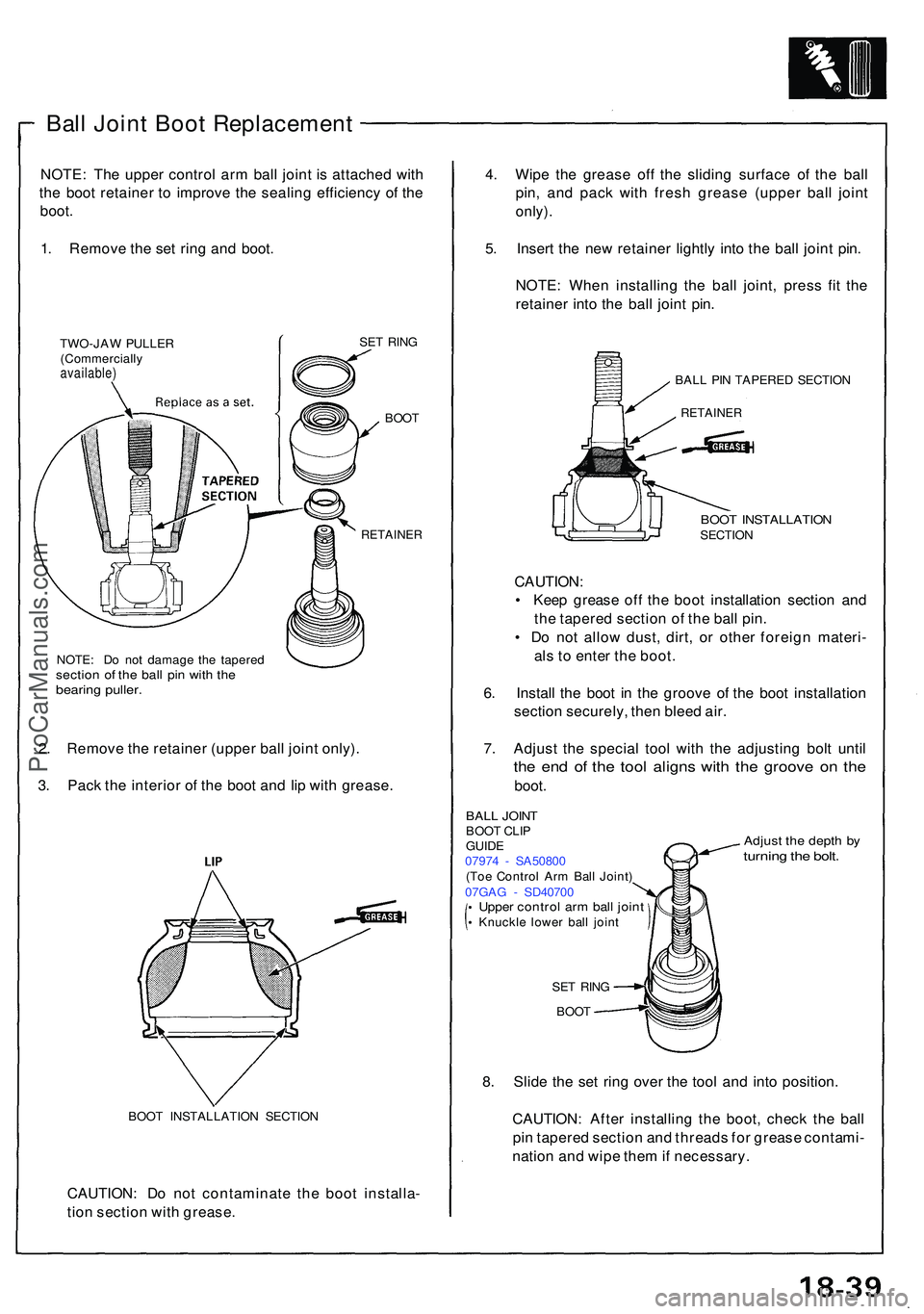
Ball Join t Boo t Replacemen t
NOTE: Th e uppe r contro l ar m bal l join t i s attache d wit h
th e boo t retaine r t o improv e th e sealin g efficienc y o f th e
boot .
1 . Remov e th e se t rin g an d boot .
TWO-JA W PULLE R
(Commerciall y
available)
SET RIN G
BOO T
RETAINE R
NOTE: D o no t damag e th e tapere dsection o f th e bal l pi n wit h th ebearin g puller .
2. Remov e th e retaine r (uppe r bal l join t only) .
3 . Pac k th e interio r o f th e boo t an d li p wit h grease .
BOOT INSTALLATIO N SECTIO N
CAUTION : D o no t contaminat e th e boo t installa -
tio n sectio n wit h grease . 4
. Wip e th e greas e of f th e slidin g surfac e o f th e bal l
pin , an d pac k wit h fres h greas e (uppe r bal l join t
only) .
5. Inser t th e ne w retaine r lightl y int o th e bal l join t pin .
NOTE : Whe n installin g th e bal l joint , pres s fi t th e
retaine r int o th e bal l join t pin .
BAL L PI N TAPERE D SECTIO N
RETAINE R
BOOT INSTALLATIO NSECTION
CAUTION :
• Kee p greas e of f th e boo t installatio n sectio n an d
th e tapere d sectio n o f th e bal l pin .
• D o no t allo w dust , dirt , o r othe r foreig n materi -
al s to ente r th e boot .
6 . Instal l th e boo t i n th e groov e o f th e boo t installatio n
sectio n securely , the n blee d air .
7 . Adjus t th e specia l too l wit h th e adjustin g bol t unti l
the en d o f th e too l align s wit h th e groov e o n th e
boot .
Adjus t th e dept h b yturnin g th e bolt .
BAL L JOIN TBOOT CLI P
GUID E
0797 4 - SA5080 0
(To e Contro l Ar m Bal l Joint )
07GA G - SD4070 0
Upper contro l ar m bal l join tKnuckl e lowe r bal l join t
SE T RIN G
BOO T
8. Slid e th e se t rin g ove r th e too l an d int o position .
CAUTION : Afte r installin g th e boot , chec k th e bal l
pi n tapere d sectio n an d thread s fo r greas e contami -
natio n an d wip e the m if necessary .
ProCarManuals.com
Page 983 of 1503
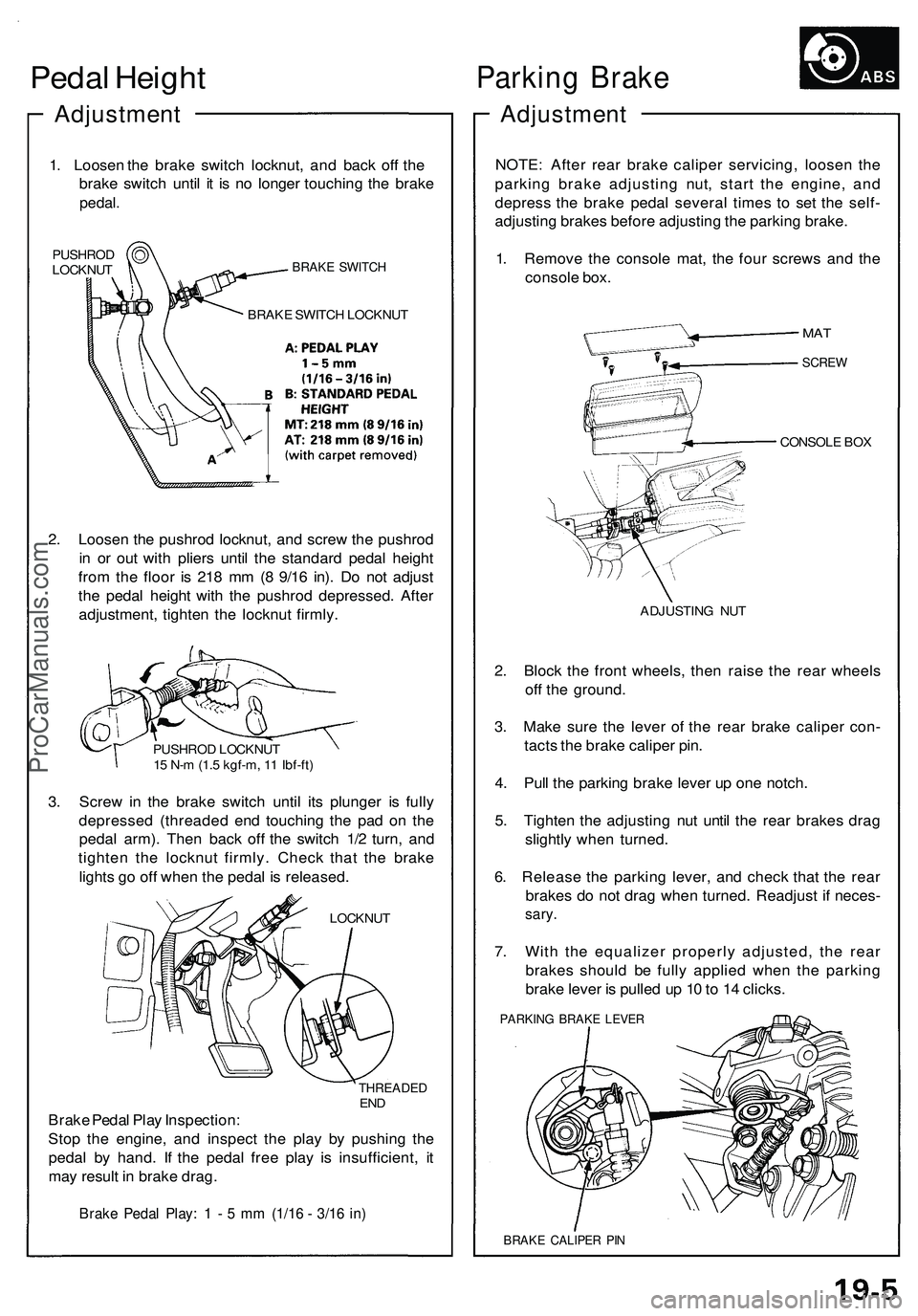
Pedal Heigh t
Adjustmen t
1. Lo osen th e brak e switc h locknut , an d bac k of f th e
brak e switc h unti l i t i s n o longe r touchin g th e brak e
pedal .
PUSHRO D
LOCKNU TBRAKE SWITC H
BRAKE SWITC H LOCKNU T
2. Loose n th e pushro d locknut , an d scre w th e pushro d
i n o r ou t wit h plier s unti l th e standar d peda l heigh t
fro m th e floo r i s 21 8 m m (8 9/1 6 in) . D o no t adjus t
th e peda l heigh t wit h th e pushro d depressed . Afte r
adjustment , tighte n th e locknu t firmly .
PUSHRO D LOCKNU T
1 5 N- m (1. 5 kgf-m , 1 1 Ibf-ft )
3. Scre w in th e brak e switc h unti l it s plunge r i s full y
depresse d (threade d en d touchin g th e pa d o n th e
peda l arm) . The n bac k of f th e switc h 1/ 2 turn , an d
tighte n th e locknu t firmly . Chec k tha t th e brak e
light s g o of f whe n th e peda l i s released .
LOCKNUT
THREADE DEND
Brak e Peda l Pla y Inspection :
Sto p th e engine , an d inspec t th e pla y b y pushin g th e
peda l b y hand . I f th e peda l fre e pla y i s insufficient , i t
ma y resul t i n brak e drag .
Brake Peda l Play : 1 - 5 m m (1/1 6 - 3/1 6 in )
Parkin g Brak e
Adjustmen t
NOTE: Afte r rea r brak e calipe r servicing , loose n th e
parkin g brak e adjustin g nut , star t th e engine , an d
depres s th e brak e peda l severa l time s t o se t th e self -
adjustin g brake s befor e adjustin g th e parkin g brake .
1 . Remov e th e consol e mat , th e fou r screw s an d th e
consol e box .
CONSOL E BO X
ADJUSTIN G NU T
2. Bloc k th e fron t wheels , the n rais e th e rea r wheel s
of f th e ground .
3 . Mak e sur e th e leve r o f th e rea r brak e calipe r con -
tact s th e brak e calipe r pin .
4 . Pul l th e parkin g brak e leve r u p on e notch .
5 . Tighte n th e adjustin g nu t unti l th e rea r brake s dra g
slightl y whe n turned .
6 . Releas e th e parkin g lever , an d chec k tha t th e rea r
brake s d o no t dra g whe n turned . Readjus t i f neces -
sary.
7. Wit h th e equalize r properl y adjusted , th e rea r
brake s shoul d b e full y applie d whe n th e parkin g
brak e leve r i s pulle d u p 1 0 to 1 4 clicks .
PARKIN G BRAK E LEVE R
BRAKE CALIPE R PI N
MA T
SCRE W
ProCarManuals.com
Page 985 of 1503
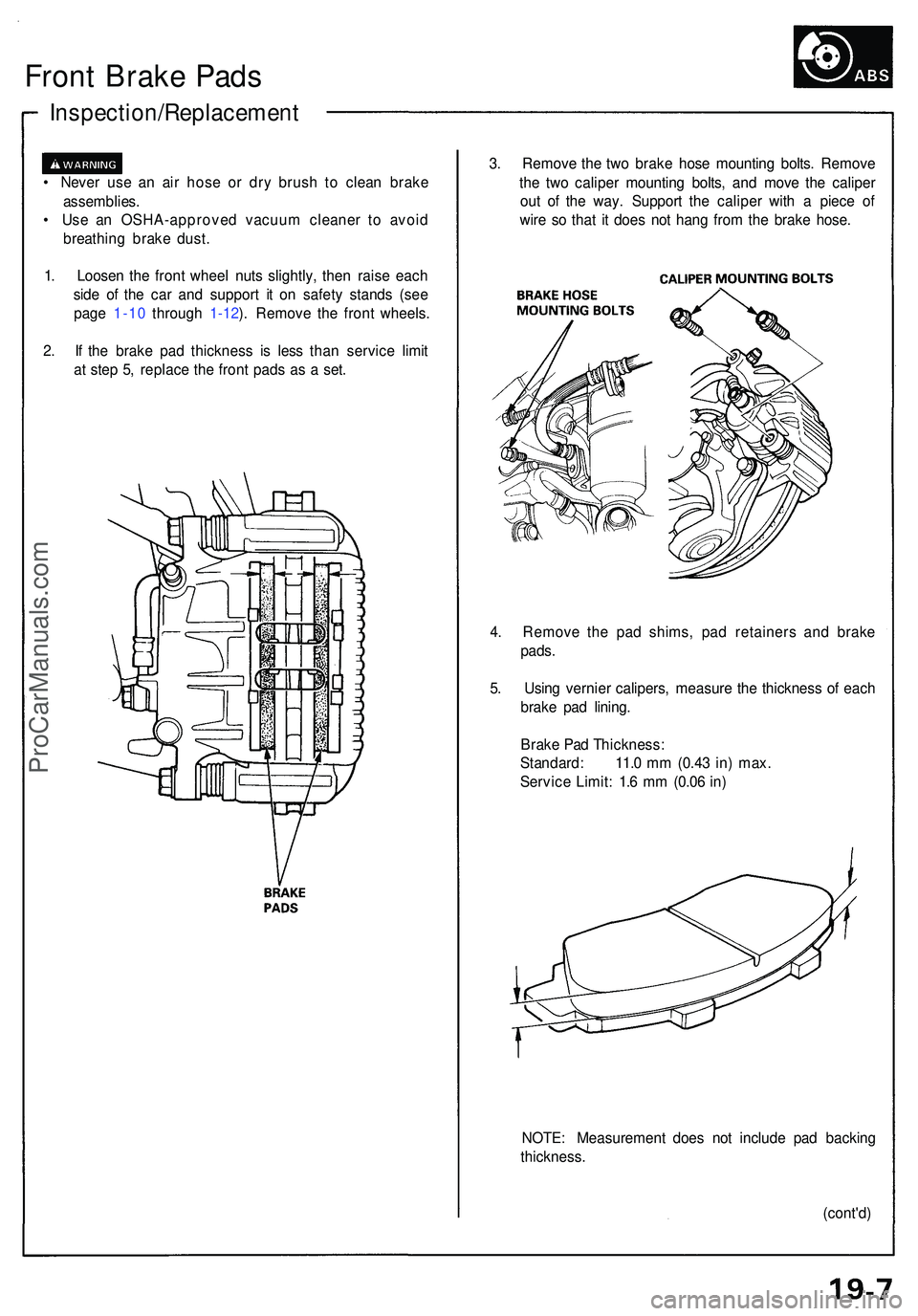
Front Brak e Pad s
Inspection/Replacemen t
• Neve r us e a n ai r hos e o r dr y brus h t o clea n brak e
assemblies .
• Us e a n OSHA-approve d vacuu m cleane r t o avoi d
breathin g brak e dust .
1 . Loose n th e fron t whee l nut s slightly , the n rais e eac h
sid e o f th e ca r an d suppor t i t o n safet y stand s (se e
pag e 1-10 throug h 1-12 ). Remov e th e fron t wheels .
2 . I f th e brak e pa d thicknes s i s les s tha n servic e limi t
a t ste p 5 , replac e th e fron t pad s a s a set . 3
. Remov e th e tw o brak e hos e mountin g bolts . Remov e
th e tw o calipe r mountin g bolts , an d mov e th e calipe r
ou t o f th e way . Suppor t th e calipe r wit h a piec e o f
wir e s o tha t i t doe s no t han g fro m th e brak e hose .
4 . Remov e th e pa d shims , pa d retainer s an d brak e
pads .
5 . Usin g vernie r calipers , measur e th e thicknes s o f eac h
brak e pa d lining .
Brak e Pa d Thickness :
Standard : 11. 0 m m (0.4 3 in ) max .
Servic e Limit : 1. 6 m m (0.0 6 in )
NOTE : Measuremen t doe s no t includ e pa d backin g
thickness .
(cont'd)
ProCarManuals.com
Page 994 of 1503
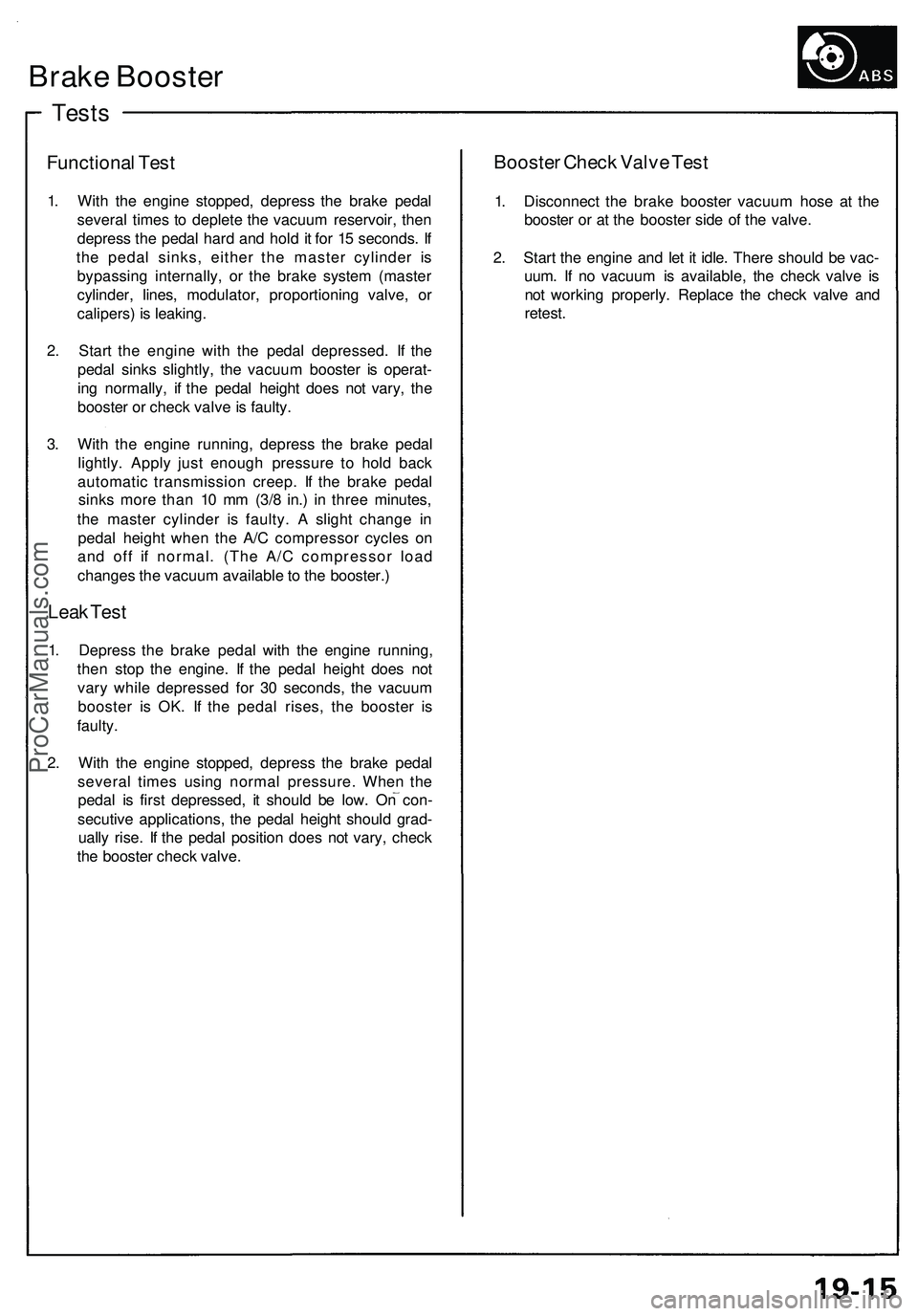
Tests
Brake Booster
Functional Test
1. With the engine stopped, depress the brake pedal
several times to deplete the vacuum reservoir, then
depress the pedal hard and hold it for 15 seconds. If
the pedal sinks, either the master cylinder is
bypassing internally, or the brake system (master
cylinder, lines, modulator, proportioning valve, or
calipers) is leaking.
2. Start the engine with the pedal depressed. If the
pedal sinks slightly, the vacuum booster is operat-
ing normally, if the pedal height does not vary, the
booster or check valve is faulty.
3. With the engine running, depress the brake pedal
lightly. Apply just enough pressure to hold back
automatic transmission creep. If the brake pedal
sinks more than 10 mm (3/8 in.) in three minutes,
the master cylinder is faulty. A slight change in
pedal height when the A/C compressor cycles on
and off if normal. (The A/C compressor load
changes the vacuum available to the booster.)
Leak Test
1. Depress the brake pedal with the engine running,
then stop the engine. If the pedal height does not
vary while depressed for 30 seconds, the vacuum
booster is OK. If the pedal rises, the booster is
faulty.
2. With the engine stopped, depress the brake pedal
several times using normal pressure. When the
pedal is first depressed, it should be low. On con-
secutive applications, the pedal height should grad-
ually rise. If the pedal position does not vary, check
the booster check valve.
Booster Check Valve Test
1. Disconnect the brake booster vacuum hose at the
booster or at the booster side of the valve.
2. Start the engine and let it idle. There should be vac-
uum. If no vacuum is available, the check valve is
not working properly. Replace the check valve and
retest.ProCarManuals.com
Page 997 of 1503
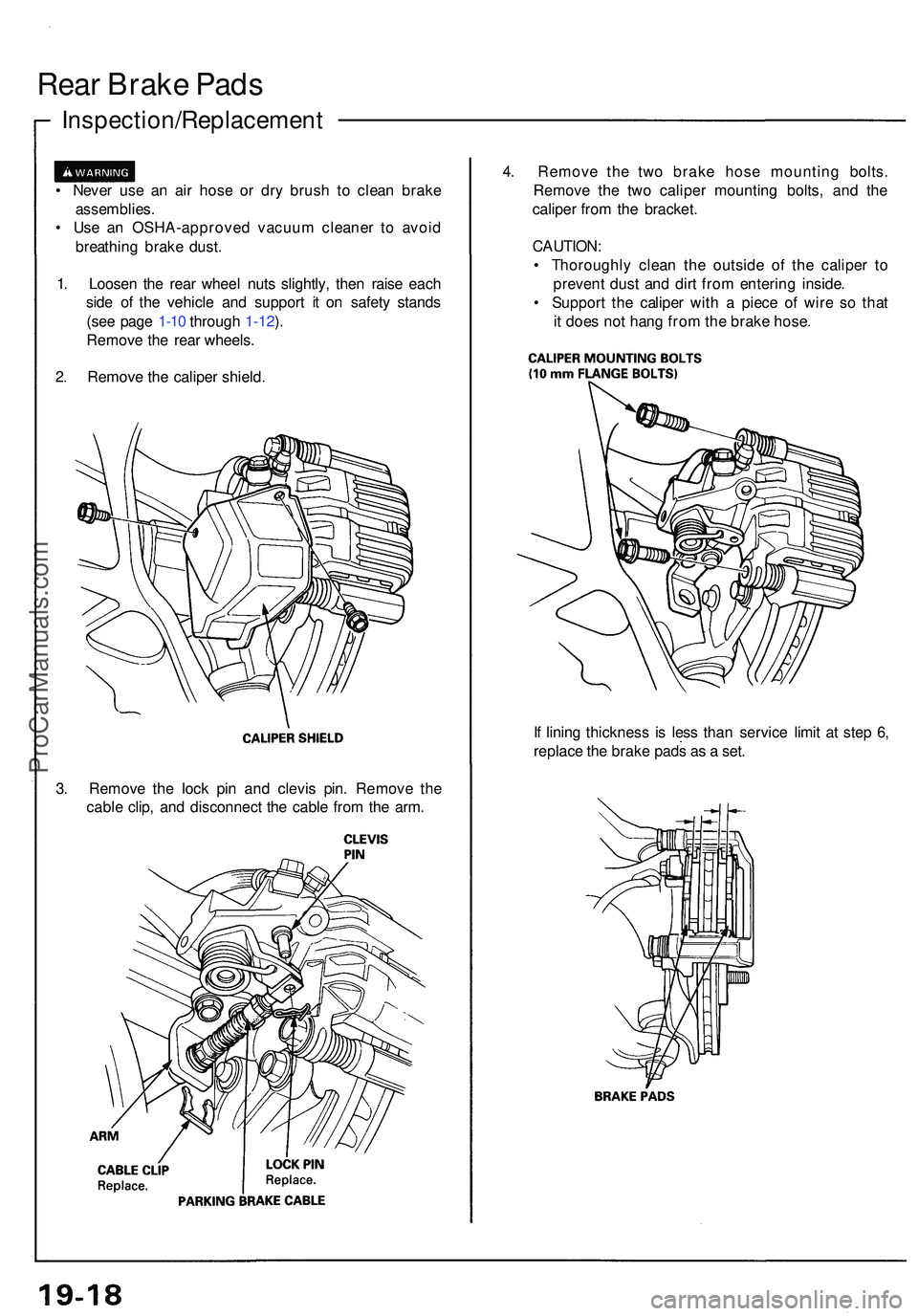
Rear Brak e Pad s
Inspection/Replacemen t
• Neve r us e a n ai r hos e o r dr y brus h t o clea n brak e
assemblies .
• Us e a n OSHA-approve d vacuu m cleane r t o avoi d
breathin g brak e dust .
1 . Loose n th e rea r whee l nut s slightly , the n rais e eac h
sid e o f th e vehicl e an d suppor t i t o n safet y stand s
(se e pag e 1-10 throug h 1-12 ).
Remov e th e rea r wheels .
2 . Remov e th e calipe r shield . 4
. Remov e th e tw o brak e hos e mountin g bolts .
Remov e th e tw o calipe r mountin g bolts , an d th e
calipe r fro m th e bracket .
CAUTION :
• Thoroughl y clea n th e outsid e o f th e calipe r t o
preven t dus t an d dir t fro m enterin g inside .
• Suppor t th e calipe r wit h a piec e o f wir e s o tha t
i t doe s no t han g fro m th e brak e hose .
I f linin g thicknes s i s les s tha n servic e limi t a t ste p 6 ,
replac e th e brak e pad s a s a set .
3 . Remov e th e loc k pi n an d clevi s pin . Remov e th e
cabl e clip , an d disconnec t th e cabl e fro m th e arm .
ProCarManuals.com
Page 1010 of 1503
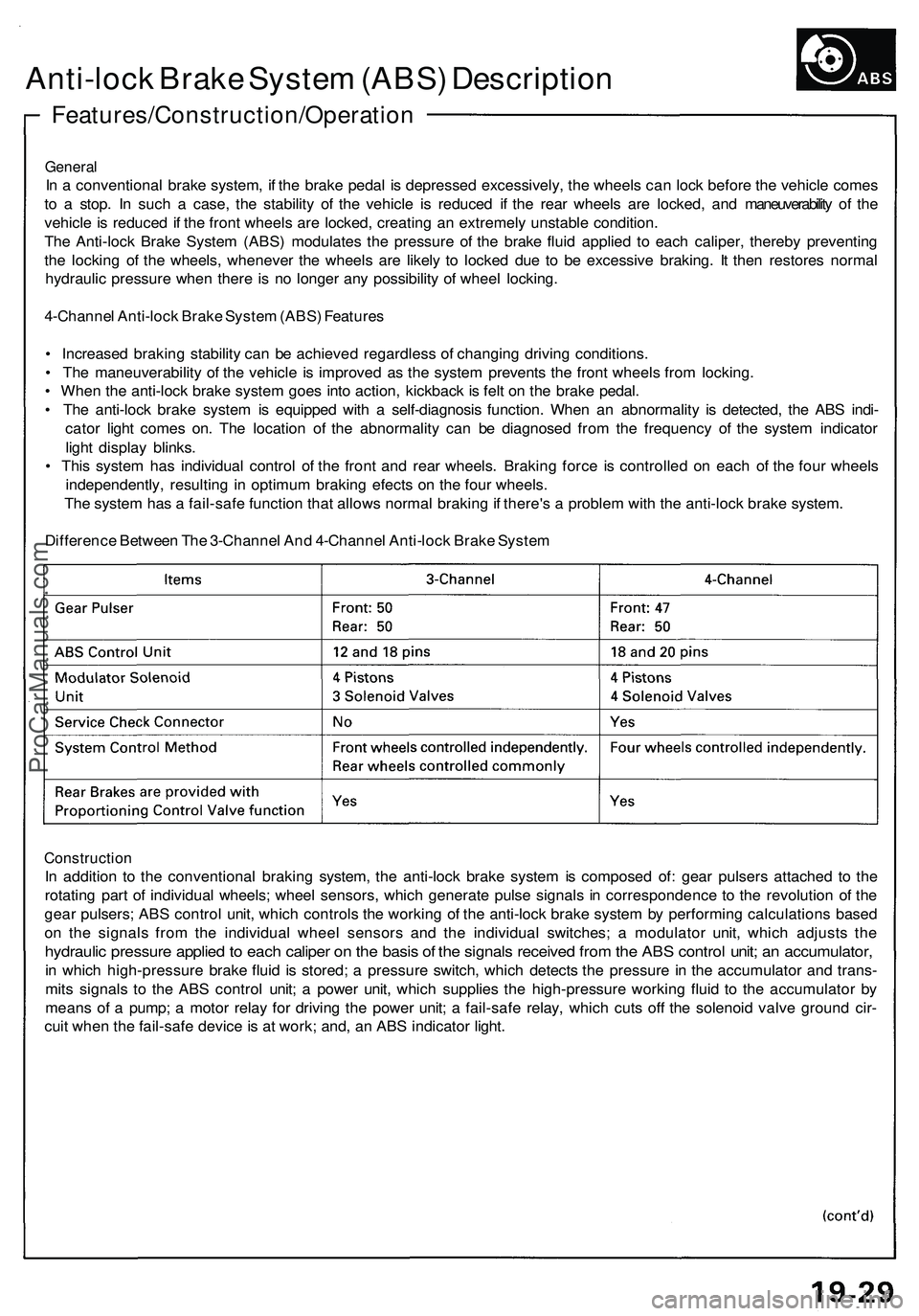
Features/Construction/Operation
Anti-lock Brake System (ABS) Description
General
In a conventional brake system, if the brake pedal is depressed excessively, the wheels can lock before the vehicle comes
to a stop. In such a case, the stability of the vehicle is reduced if the rear wheels are locked, and maneuverability of the
vehicle is reduced if the front wheels are locked, creating an extremely unstable condition.
The Anti-lock Brake System (ABS) modulates the pressure of the brake fluid applied to each caliper, thereby preventing
the locking of the wheels, whenever the wheels are likely to locked due to be excessive braking. It then restores normal
hydraulic pressure when there is no longer any possibility of wheel locking.
4-Channel Anti-lock Brake System (ABS) Features
• Increased braking stability can be achieved regardless of changing driving conditions.
• The maneuverability of the vehicle is improved as the system prevents the front wheels from locking.
• When the anti-lock brake system goes into action, kickback is felt on the brake pedal.
• The anti-lock brake system is equipped with a self-diagnosis function. When an abnormality is detected, the ABS indi-
cator light comes on. The location of the abnormality can be diagnosed from the frequency of the system indicator
light display blinks.
• This system has individual control of the front and rear wheels. Braking force is controlled on each of the four wheels
independently, resulting in optimum braking efects on the four wheels.
The system has a fail-safe function that allows normal braking if there's a problem with the anti-lock brake system.
Difference Between The 3-Channel And 4-Channel Anti-lock Brake System
Construction
In addition to the conventional braking system, the anti-lock brake system is composed of: gear pulsers attached to the
rotating part of individual wheels; wheel sensors, which generate pulse signals in correspondence to the revolution of the
gear pulsers; ABS control unit, which controls the working of the anti-lock brake system by performing calculations based
on the signals from the individual wheel sensors and the individual switches; a modulator unit, which adjusts the
hydraulic pressure applied to each caliper on the basis of the signals received from the ABS control unit; an accumulator,
in which high-pressure brake fluid is stored; a pressure switch, which detects the pressure in the accumulator and trans-
mits signals to the ABS control unit; a power unit, which supplies the high-pressure working fluid to the accumulator by
means of a pump; a motor relay for driving the power unit; a fail-safe relay, which cuts off the solenoid valve ground cir-
cuit when the fail-safe device is at work; and, an ABS indicator light.ProCarManuals.com